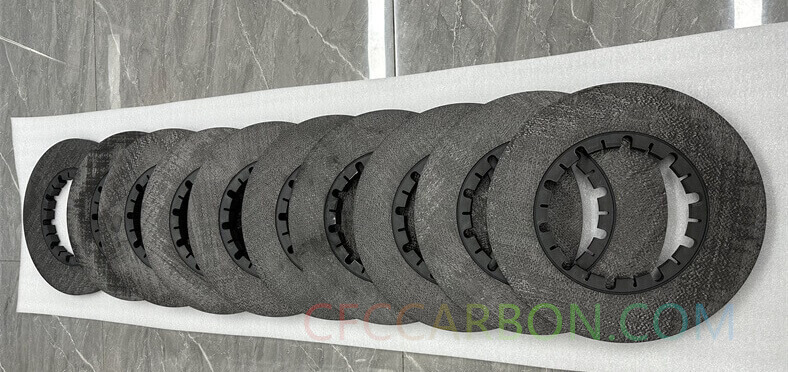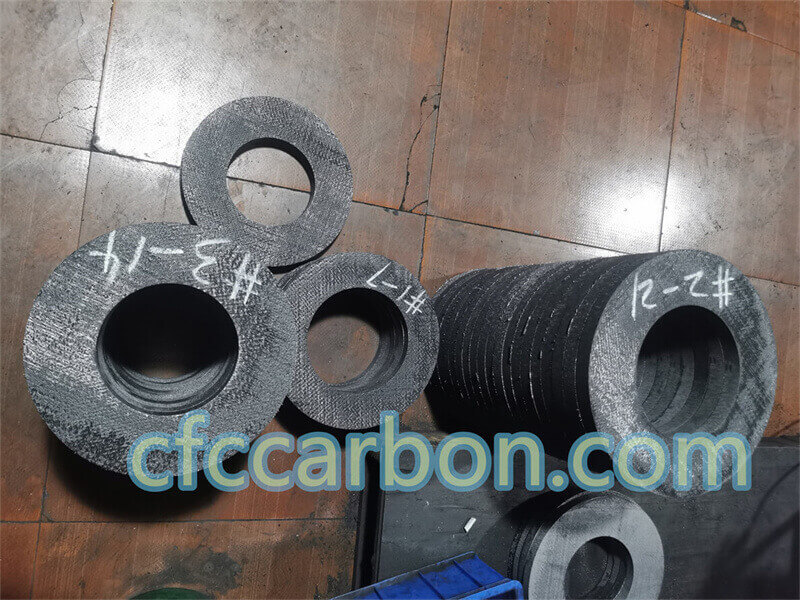Title: Understanding Catalytic Oxidation in Carbon-Carbon Aircraft Brakes: Mechanisms and Mitigation Strategies
Introduction
Carbon-carbon composite (C-C) materials in aircraft braking systems face a critical challenge: catalytic oxidation triggered by alkali metal salts from marine environments and de-icing fluids. Sodium and potassium compounds, in particular, dramatically accelerate oxidation rates, compromising structural integrity even at minimal weight loss (2.5–5%). This article explores the mechanisms behind this

airplane brake disc-aircraft carbon fiber composite material manufacturer- (2)
phenomenon and highlights research-driven strategies to mitigate its impact.
The Threat of Alkali Metal Catalysts
During aircraft operation, alkali salts infiltrate C-C brake surfaces, initiating catalytic oxidation. Studies reveal that sodium and potassium compounds are especially potent, increasing oxidation rates by over tenfold. For instance, potassium carbonate (K₂CO₃) reduces compression strength significantly at low weight loss thresholds. Research by Duvivier et al. further demonstrates that oxidation rates plateau once catalyst content exceeds 0.80%, emphasizing that even trace amounts of these salts pose severe risks.
Key Research Findings on Catalytic Mechanisms
-
Vapor-Cycle Diffusion
Adjorlolo and Rao’s work on metallurgical coke gasification identified a “vapor-cycle” mechanism, where alkali metals diffuse rapidly into carbon matrices. Their proposed reactions (simplified below) explain sustained catalytic activity:
-
M₂CO₃(s) + 2C → 2M(g) + 3CO(g)
-
2M(g) + 2CO₂(g) → M₂CO₃(s) + CO(g)
This cycle regenerates catalysts, enabling deep penetration into C-C composites.
carbon fiber composite airplane brake disc-semi-products-material
-
Thermodynamic Drivers
Rao et al. found potassium carbonate (K₂CO₃) more effective than sodium carbonate (Na₂CO₃) due to stronger thermodynamic driving forces. However, Na₂CO₃ occasionally outperformed K₂CO₃ in studies, likely due to synergistic effects with impurities in coke. -
Surface Interactions
Mims and co-workers highlighted the role of C-O-K complexes on carbon surfaces, which enhance oxygen adsorption and electron transfer. Zahedi and Miller further emphasized that surface oxygen groups are critical for maintaining catalytic activity.
Melting Behavior Below Expected Thresholds
Intriguingly, potassium carbonate particles adhere to carbon fibers even at 600°C—well below their melting point (891°C). McKee and Chatterji’s thermogravimetric analyses revealed that alkali carbonates decompose via carbon-assisted reactions below 600°C:
M₂CO₃ + C + O₂ → M₂O + 2CO₂
This generates reactive peroxides (e.g., K₂O₂), which melt at lower temperatures and drive oxidation.
Periodic Trends and Practical Implications
Catalytic activity increases with alkali metal atomic size (e.g., cesium > potassium > sodium) due to stronger peroxide formation tendencies. For aircraft brake designers, these insights underscore the need for:
-
Protective coatings to block salt infiltration.
-
Material modifications to reduce catalyst-carbon interactions.
-
Advanced monitoring systems to detect early-stage oxidation.
Industry Innovations and Resources
Recent advancements in C-C composite technology, such as those highlighted by CFC Carbon, focus on integrating oxidation-resistant additives and layered matrix designs. These innovations aim to disrupt catalytic pathways while maintaining the high thermal stability required for aviation applications.
Conclusion
The catalytic oxidation of C-C aircraft brakes remains a critical concern, but mechanistic studies provide a roadmap for mitigation. By leveraging insights into alkali metal behavior, surface chemistry, and material engineering, the aviation industry can develop next-generation braking systems that balance performance and durability. Continued collaboration between researchers and manufacturers, as seen in platforms like CFC Carbon, will be key to overcoming this challenge.
related news /articles:
Catalytic oxidation of carbon-carbon composite aircraft brakes (4)
Catalytic oxidation of carbon-carbon composite aircraft brakes (5)
Protection Mechanisms Against Catalytic Oxidation in c/c Composites (2)
Protection Strategies Against Catalytic Oxidation in carbon fiber Composite (1)